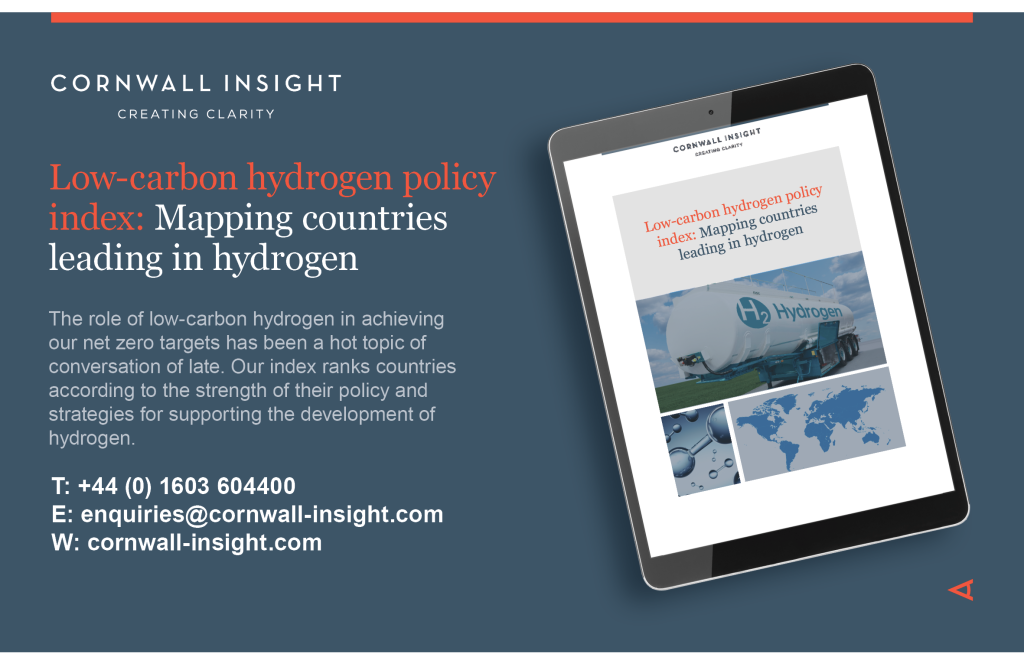The role of low-carbon hydrogen in achieving our net zero targets has been a hot topic of conversation of late, both within industry circles and in mainstream media and public conversation. As the discussion builds, Cornwall Insight has interrogated the policy and strategy frameworks presented by countries that have branded themselves as potential leaders in the new hydrogen economy.
We pick out four key results:
Germany ranks highest.
Germany ranked 1st in the index with a score of 8.1 out of 10. The country plans to be net-importing from global hydrogen supply chains and also targets significant electrolyser capacity for domestic production at 5GW by 2030, with an expectation for this to increase to 10GW with the new government.
In our index the country scored highest for ‘public finance’, an indicator which looks at funding committed by the government for developing hydrogen national markets. Under former Chancellor Angela Merkel, €7bn was earmarked to expand Germany’s role in green hydrogen domestically and €2bn for international partnerships in the context of hydrogen. These efforts have been furthered under the new coalition, which was sworn in on 8 December 2021. In 2022, the country is expected to launch renewable tenders and boost hydrogen targets ‘to triple the speed of emissions cuts’.
The German hydrogen strategy was one of the first country strategies to be published in June 2020. The strategy has a clear emphasis on green hydrogen as the dominant form of hydrogen in the country. Within Germany, this has caused some debate across industries. The focus on one form of hydrogen production is applauded by some for the clarity of direction, but concerns have been raised around the impact the narrow approach to technology preferences may have on the speed at which the market can develop. Nonetheless, at present, the country continues to lead globally in terms of the detail and development of policy surrounding hydrogen and is set to be a major player in future hydrogen supply chains globally.
South Korea scores high for strategy detail and timelines.
The incumbent Moon Jae-in government has identified hydrogen as a key engine of economic growth and job creation. At present, South Korea has committed the third-largest public investment, following Germany and Japan. Overall, the country ranked 2nd in our index.
Spain ranks in the top 3.
Spain was another country to rank highly in the index, with a score of 6.8/10. The country targets the installation of 4GW of electrolyser plants by 2030, with renewable hydrogen contributing to 25% of national hydrogen needs by the same year. Like Germany, Spain is set to focus on developing green hydrogen, utilising the country’s strong solar PV resources. Unlike Germany, the country’s role in the global supply chain will focus more specifically on export and domestic self-reliance.
UK scores high for strategy detail.
The United Kingdom ranked 5th out of 15 in our index. The country scored high for strategy detail, as well as for storage and network targets. The UK hydrogen strategy was published in August 2021. The strategy contains a timeline with targets set across the supply chain, as well as case studies illustrating progress so far. The strategy takes a technology agnostic approach, with no strong preference or expectation for the commercial dominance of green or blue hydrogen, as has been seen in countries such as Germany (green) and Japan (blue).
Table 1: Low-carbon hydrogen index ranking
| Country | Ranking |
| Germany | 1 |
| South Korea | 2 |
| Spain | 3 |
| Japan | 4 |
| United Kingdom | 5 |
Note on methodology:
The index explores countries with a strong potential for low-carbon hydrogen production or consumption, looking primarily at those which have policies and strategies to support a market for low-carbon green and blue hydrogen2. The index will be updated quarterly, and decisions on countries included will be reviewed regularly based on regulatory developments across jurisdictions. Countries composed of several states, such as the US and Australia, are evaluated at the federal level.


